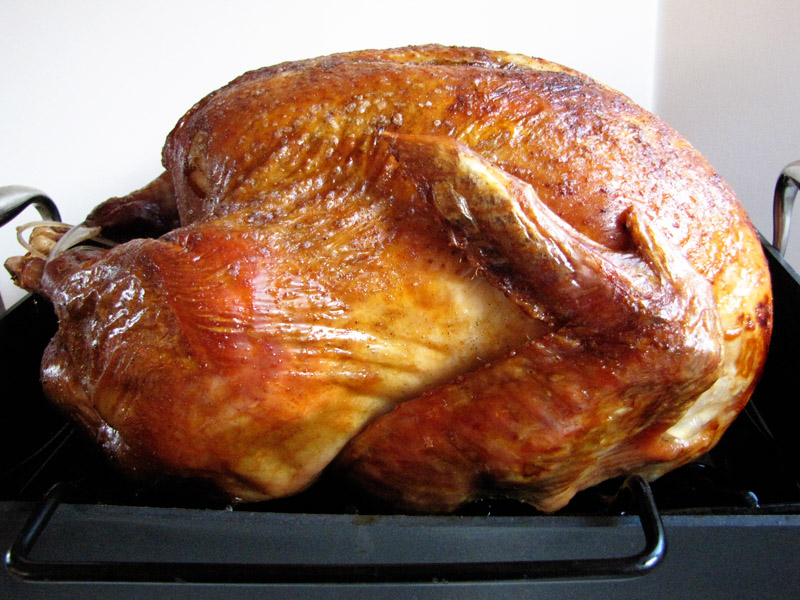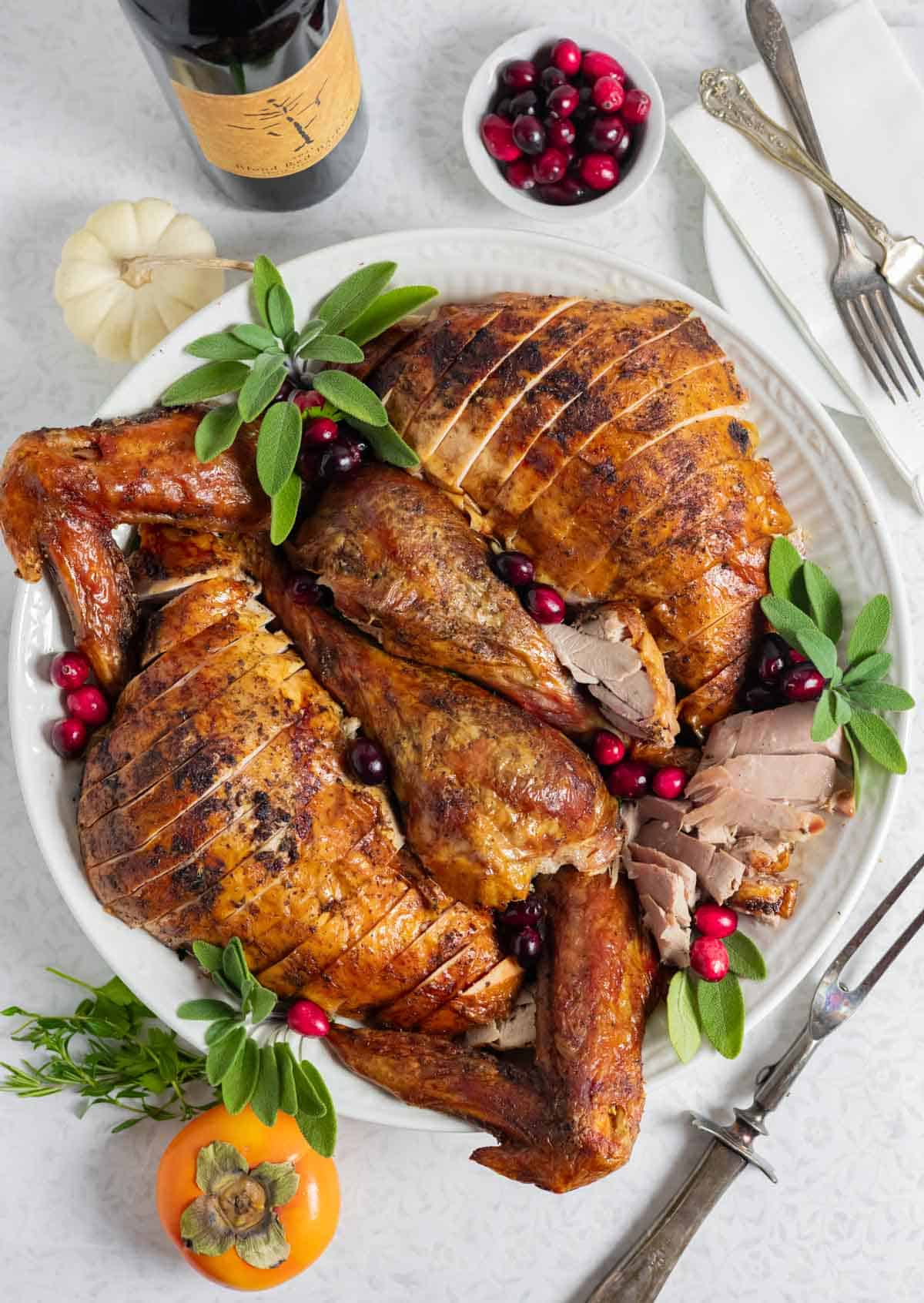Convection oven roast turkey is the best way to get crispy, golden skin with the juiciest, most tender meat. It’s a fool-proof method for how to cook the perfect turkey every time, with no basting required. And, it takes less time than a conventional oven. It’s easy to prepare and is sure to impress!
A truly mouthwatering holiday turkey is undoubtedly the centerpiece of the table. You’ll be amazed at how simple it is to use your convection oven to make the most stunning and delicious, juicy, golden brown, crispy skin turkey.
Do you have a convection oven and tend to not use the convection feature? Me too. Well, that is until I tried it for a few recipes and now I use it with almost every recipe, especially baking whole roasted chicken and turkey. Once you roast your Thanksgiving or Christmas turkey using convection, there’s no going back. Trust me.
Serve this with Sugar-Free Cranberry Jam as a cranberry sauce alternative, and low-carb and low-FODMAP sides including Brussels Sprouts with Maple and Rosemary, or some buttery Colcannon made with rutabagas as a low-carb potato replacement.
Roasting a juicy, flavorful turkey is one of the highlights of the holiday season. As you prepare your Thanksgiving feast, you may be wondering whether it’s better to bake or convection roast your turkey for optimal results. Both methods have their advantages, so let’s take a closer look to determine which is right for your holiday meal.
What is Convection Roasting?
A convection oven has a built-in fan that circulates hot air around the turkey as it cooks This allows the heat to reach all sides of the bird more evenly Convection roasting uses a combination of normal baking heat from the bottom and intense dry heat from the top, resulting in a turkey with crispy, browned skin.
Here are some of the benefits of convection roasting your turkey
-
Cooks the turkey 25-30% faster than a conventional oven. This time savings can be handy when you have multiple dishes to prepare.
-
Produces an evenly browned exterior. The circulating air prevents cold and hot spots.
-
Cooks the turkey more evenly throughout. You’ll avoid having dry breast meat and undercooked legs.
-
Creates a crispy skin without frequent basting. The constant flow of hot air crisps and browns the skin.
-
Seals in juices for a moist interior. The quick, high heat sears the outside and locks in moisture.
How to Convection Roast a Turkey
Roasting a turkey in a convection oven is simple:
-
Place the seasoned turkey on a rack in a roasting pan. Do not tie the legs together or truss.
-
Set the oven to 325-350°F with the convection roast setting turned on.
-
Roast until the thickest part of the thigh reaches 165°F, about 2-2.5 hours for a 15-pound turkey.
-
Let the turkey rest at least 20 minutes before slicing to allow juices to redistribute.
What is Standard Oven Roasting?
A standard oven relies on radiant heat from the top and bottom to cook food. There is no fan circulating the hot air, so the turkey is heated from the outside in. This slower cooking method requires more frequent basting to prevent the skin from drying out.
Here are some characteristics of roasting a turkey in a standard oven:
-
Takes more time than convection roasting, around 3-3.5 hours for a 15-pound turkey.
-
Produces less even browning since there are cold and hot spots in the oven.
-
Requires basting with broth or oil every 30 minutes starting at the halfway point.
-
Can result in slightly drier breast meat if not basted frequently enough.
-
Typically produces a less crisp skin than convection roasting.
How to Roast a Turkey in a Standard Oven
To roast your turkey in a regular oven:
-
Place turkey on a rack in a roasting pan and tie the legs together to hold its shape.
-
Set the oven to 325°F. Do not use the convection setting.
-
Roast until the thigh reaches 165°F, around 3 hours for a 15-pound turkey.
-
Baste every 30 minutes once the halfway point is reached to prevent drying out.
-
Let rest 20+ minutes before carving.
Convection vs. Standard Roasting Comparison
| Factor | Convection Roasting | Standard Roasting |
|---|---|---|
| Cooking Time | 25-30% faster | Longer (up to 1.5 hours more) |
| Browning | Very even and crisp | Less even, requires rotating |
| Basting | Not needed | Required every 30 minutes |
| Moisture Level | Very juicy | Can be slightly drier breast meat |
| Skin Crispness | Excellent | Good if basted well |
Choosing Between the Two Methods
So when it comes to producing the perfect holiday turkey, is it better to bake or convection roast? Here are some factors to help you decide:
If you want moist, juicy meat:
Either method works if the turkey is cooked properly to 165°F. Convection roasting seals in juices well, but standard roasting with frequent basting also produces a moist interior.
If you want crispy, browned skin:
Convection roasting blows hot air over every surface, so it excels at creating crisp, flavorful turkey skin. With standard roasting, basting is required to crisp the skin.
If you have time constraints:
The shorter cooking time makes convection roasting the better choice when time is tight. It can shave 45-90 minutes off the roasting time.
If you have lots of dishes using the oven:
Convection roasting lets you cook side dishes at the same time since it heats the oven more evenly. With standard roasting, cold and hot spots may affect bakeware placement.
If you love tradition:
Some argue that standard roasting gives a more authentic turkey flavor. The steady, radiant heat is reminiscent of oven roasting over decades past.
Alternating Between the Two Methods
One option is to get the benefits of both methods by switching from standard to convection roasting partway through. Here are two approaches:
-
Roast the turkey for 1-2 hours at 325°F in a standard oven to allow the skin to partially crisp. Then increase to 350°F convection roast to finish cooking quickly.
-
Start the turkey at 350°F convection until the skin crisps and seals in moisture. Reduce to 325°F standard roast to finish gently heating the interior.
This lets you customize browning, cook times, and moisture levels by leveraging both roasting techniques.
Key Tips for Roasting Turkey Success
To ensure flawless turkey no matter which roasting method you use:
-
Always use a meat thermometer to verify doneness rather than relying on cook times alone. Cook to 165°F in the thickest part of the thigh.
-
Allow the roasted turkey to rest at least 20 minutes before carving so juices redistribute into the meat.
-
Roast your turkey on a rack inside a roasting pan to allow air circulation on all sides.
-
Season the turkey generously under the skin and in the cavity for maximum flavor.
-
Cook stuffing in a casserole dish rather than inside the turkey to prevent bacterial contamination.
Convection Roast for Fast Results or Standard Roast for Tradition
When it comes to delivering a perfect holiday turkey, both convection roasting and standard oven roasting are excellent options. Convection roasting cuts cooking time considerably while producing a browned, juicy turkey. Standard roasting requires more work but gives a nostalgic roasted flavor. Whichever you choose, use a meat thermometer and rest your turkey properly for a mouthwatering centerpiece to your Thanksgiving meal.

Temperature to cook a convection oven turkey
On the convection setting it should be cooked at a lower temperature (325°F), where roasting in a conventional oven is typically done at a higher temperature (350°F).
It’s best to place it on the lowest rack, where the bird itself will be centered in the oven.
How long to rest a turkey
It’s best to rest the bird for 20-30 minutes before carving. Tent with foil and let sit at room temperature. The temperature will continue to rise during part of the resting process, called carryover cooking. When the temperature begins to fall, the juices will re-absorb into the muscle fibers, making the meat tender and juicy. Resting also makes it easier to carve.

Is it better to cook a turkey in a convection oven or regular oven?
FAQ
Is it better to convection bake or convection roast a turkey?
What is the best oven setting for a turkey?
Should turkey be 325 or 350 in a convection oven?
Is convection better for baking or roasting?
